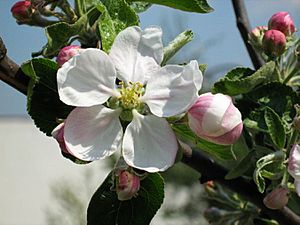Malus asiatica facts for kids
Quick facts for kids Malus asiatica |
|
|---|---|
 |
|
| Conservation status | |
| Scientific classification |
Malus asiatica is a special type of crabapple tree. It's also known as the Chinese pearleaf crabapple because its leaves can look a bit like pear tree leaves. This tree belongs to the Malus genus, which includes all apple trees, and it's part of the Rosaceae family, which is the rose family! This amazing tree originally comes from China and Korea.
Contents
What is a Crabapple?
A crabapple is a type of apple tree that produces small, often tart fruits. Most apples we eat today come from a different species, Malus domestica. Crabapples are usually smaller than regular apples, often less than two inches (5 cm) across. Even though they are small, they are very important!
Different Kinds of Crabapples
There are many different kinds of crabapple trees. They come in various sizes and shapes. Some have beautiful flowers, while others are known for their colorful fruits. The Chinese pearleaf crabapple is just one of these many interesting types.
Where the Chinese Pearleaf Crabapple Grows
This special crabapple tree is native to East Asia. It grows naturally in parts of China and Korea. These regions have climates that are just right for this tree to thrive. It can be found in forests, on hillsides, and sometimes near villages.
Climate and Soil
Malus asiatica prefers areas with a temperate climate. This means it likes places that have clear seasons, with warm summers and cold winters. It grows best in well-drained soil. This type of soil allows water to pass through easily, which is good for the tree's roots.
What the Chinese Pearleaf Crabapple Looks Like
The Chinese pearleaf crabapple is a medium-sized tree. It can grow quite tall, often reaching heights of 15 to 25 feet (4.5 to 7.5 meters). Its branches spread out, giving it a nice, rounded shape.
Leaves and Flowers
The leaves of Malus asiatica are usually oval-shaped. They have fine teeth along their edges. In the spring, before the leaves fully appear, the tree bursts into bloom. It produces beautiful white or pinkish-white flowers. These flowers often grow in clusters, making the tree look stunning. The blossoms are very attractive to bees and other helpful insects.
The Fruit
After the flowers fade, small fruits begin to form. These fruits are like tiny apples. They are usually round or slightly pear-shaped. When they are ripe, they can be yellow, red, or a mix of both colors. The taste of these crabapples can vary. Some are quite sour, while others are mildly sweet.
Uses of the Chinese Pearleaf Crabapple
Even though these crabapples are small and sometimes tart, they have many uses. People have used them for food and other purposes for a long time.
Food and Drink
The fruits of Malus asiatica can be eaten fresh, but they are often used in cooking. They are great for making jams, jellies, and preserves. Their tartness adds a wonderful flavor to these sweet treats. Sometimes, they are also used to make cider or other drinks. In some areas, people pickle the fruits.
Ornamental Tree
Because of its beautiful spring flowers and colorful autumn fruits, the Chinese pearleaf crabapple is also planted as an ornamental tree. This means people grow it in gardens and parks just for its beauty. It adds a lovely touch to landscapes.
Life Cycle of the Crabapple
Like all trees, the Chinese pearleaf crabapple goes through a life cycle. It starts as a seed and grows into a mature tree that can produce its own seeds.
From Seed to Tree
The life cycle begins with a tiny seed. If the seed lands in good soil and gets enough water and sunlight, it will sprout. A small seedling emerges, which slowly grows into a young tree. Over several years, the young tree matures.
Flowering and Fruiting
Once the tree is mature enough, it starts to produce flowers in the spring. These flowers are pollinated, often by insects like bees. After successful pollination, the flowers develop into fruits. Inside each fruit are seeds. When the fruits ripen and fall, the seeds can start the cycle all over again. The tree continues this cycle year after year, providing beauty and fruit.
Images for kids
See also
 In Spanish: Malus asiatica para niños
In Spanish: Malus asiatica para niños



